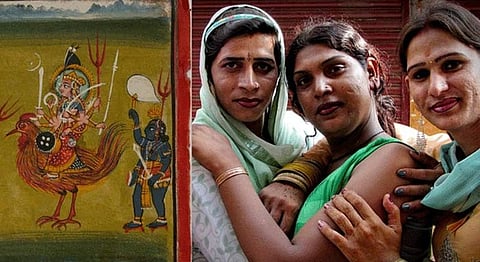
- HOMEGROWN WORLD
- #HGCREATORS
- #HGEXPLORE
- #HGVOICES
- #HGSHOP
- CAREERS
- ABOUT US
- CONTACT US

Sexual ambivalence has been a recurring motif in figures populating the world of ancient Indian mythology. Tales in regional folklore as well as the epic texts refer to both deities and heroes as well as non-divine figures changing genders, or manifesting as avatars of the opposite sex, such as Adhanari or Ardhaniswara, one of Shiva’s most popular avatars who is half-man and half-woman. In Vedic literature, the Kama Sutra, too, has spoken of the various branches of the queer community.
It is worth questioning the state of current society, in this context, when alternative sexualities are only now breaking the taboo; being queer is an idea that is slowly assimilating into the fabric of Indian society, and not without considerable outrage and pushback from those who subscribe to other notions of ‘Indian culture’ either. In spite of these, there have been a slew of events in the recent past that have been tangible steps towards being more inclusive of sexual variance in society, giving us hope that we’re moving towards a future where there is enough empathy in each of us to accept sexual ambiguity without the need to validate it to a T.
Bahuchara Mata is one of the pivotal Hindu deities who enjoys the patronage of the transgender and transvestite community in India, with several different tales in folklore depicting unmistakeable gender transformation and thus, shedding the trappings of heteronormativity. While there aren’t any direct references to homosexuality in ancient Hindu literary texts, there are several to the fluid nature of sexuality.
Daughter of Charan Bapal and Detha, one myth tells us about how she was travelling with her sisters in a caravan when a bandit named Bapiya accosted them on the journey. It was common for both men and women of the charan community to kill themselves when faced with the prospect of being overpowered and killed by enemies; and shedding the blood of a charan was considered abominable. The sisters announced Tragu, a form of self-immolation, upon being attacked and legend has it that they cut off their breasts, with Bahuchara cursing Bapiya to a life of impotency unless he dressed and acted like a woman, and worshipped her for the rest of his days. The underlying message here is simple — impotence or genital mutilation are again recurring themes in tales associated with Bahuchara Mata.
Another myth tells of a king who prayed to the Goddess for a son, who was eventually born impotent. The prince, Jetho, dreamt of Bahuchara one day who ordered him to cut off his genitals, wear women’s clothes and become her servant. Bahuchara Mata has consistently, over these stories, appeared as a figure who identified impotent men and commanded them to do this and serve her. If they refused to assume the attire and mannerisms of the opposite gender, they would be cursed in their next seven incarnations to be born impotent, and thus the cult of devotees who worship Bahuchara Mata grew; a community that is required to self-castrate and remain celibate. The stories also speak of the conflict between body and soul that transgenders go through, in search for their gender identity, a story from ancient times reflecting their state of mind.
In yet another of these numerous folk stories, Bahuchara was a princess whose marriage was never consummated. Her husband would, every night, slip away to the forest where he would ‘behave as a woman’ while other versions say that Bahuchara followed him one night and found him having sex with another man. Furious, she castrated him and cursed him, announcing that all men like her husband ought to be emasculated to give them a chance at a better rebirth. This same community of men was also promised protection if they worshipped her. A manifestation of the Goddess, Bahuchara is a symbol of immense strength and protection to the kinnar community in all of these stories, regardless of whether the story is about the men getting neutered or her being depicted cutting off her own breasts to save herself from the atrocity of rape; her worshippers are staunch believers in non-violence and consider killing of all animals and creatures a sin.
While the primary temple of Bahuchara Ma is located in Bechraji town in Mehsana district of Gujarat, India, the goddess is one of the central religious figures amongst hijras, with many homes having small shrines dedicated to her. Seated on a rooster (to symbolise innocence), Bahuchara Mata is often depicted as a woman who carries a sword on her top right, the abhay hasta mudra (‘showering of blessings’) on her bottom right, a trident on her bottom left and a text of scriptures on her top left. With the transgender community being recognised in India as the third gender, and the recent election of a hijra mayor, things seems promising and we seem to be moving towards a more inclusive future albeit slowly and not without setbacks. Even as we take these steps forward, though, it is important to remember that it is these stories that have laid the foundation and been a source of strength and faith, a testament to how it is not up to any faction to decide what is ‘normal’ or ‘natural’. Much like the story of Nangeli, the 19th century Dalit woman, it is uplifting to discover in ancient Indian history and mythology traces of a community who are slowly regaining their rightful place in our society.
We suggest you read:
